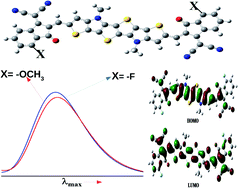Theoretical investigation of fused N-methyl-dithieno-pyrrole derivatives in the context of acceptor–donor–acceptor approach†
Abstract
In this work we have theoretically investigated the optoelectronic properties of a series of acceptor–donor–acceptor type molecules by employing density functional theory formalism. We have used 1,1-dicyano-methylene-3-indanone as the acceptor unit and a fused N-methyl-dithieno-pyrrole as the donor unit. We have calculated the values of dihedral angle, inter-ring bond length, bond length alteration parameters, HOMO–LUMO gap, ionization potential, electron affinity, partial density of states, reorganization energies for holes and electrons, charge transfer rate for holes and electrons of the seven types of compounds designed via molecular engineering. Calculated IP and EA values manifest that PBDB-C2 shows excellent charge transportation compared to others. Absorption spectra of the designed compounds have been studied using the time-dependent density functional theory method. From the calculation of reorganization energy it is confirmed that our designed molecules behave more likely as donor materials. Our calculated results also reveal that compounds with electron donating substituents at the acceptor units show higher value of λmax. Absorption spectra of donor/acceptor blends show similar trends with the isolated compounds. Observed lower exciton binding energy values for all the compounds indicate facile charge carrier separation at the donor/acceptor interface. Moreover, the negative values of Gibb's free energy change also indicate the ease of exciton dissociation of all the designed compounds. The photovoltaic characteristics of the studied compounds infer that all the designed compounds have the potential to become suitable candidate for the fabrication of organic semiconductors. However, PBDB-C2 and PBDB-C4 with the highest PCE of 18.25% can become the best candidate for application in photovoltaics.



 Please wait while we load your content...
Please wait while we load your content...